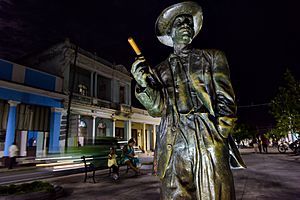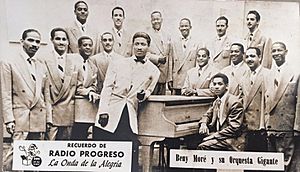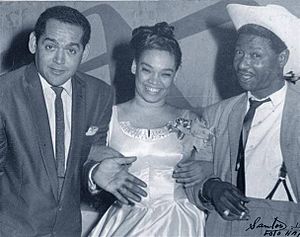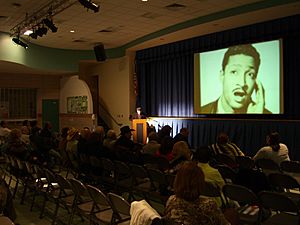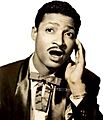Benny Moré facts for kids
Quick facts for kids
Benny Moré
|
|
|---|---|
 |
|
| Background information | |
| Birth name | Bartolomé Maximiliano Moré Gutiérrez |
| Born | 24 August 1919 Santa Isabel de las Lajas, Cuba |
| Died | 19 February 1963 (aged 43) Havana, Cuba |
| Genres | Son montuno, mambo, guaracha, bolero, afro |
| Occupation(s) | Musician, bandleader |
| Instruments | Vocals, guitar |
| Years active | 1944–1963 |
| Labels | RCA Victor, Discuba |
| Associated acts | Conjunto Matamoros, Mariano Mercerón, Bebo Valdés, Ernesto Duarte Brito, Orquesta Aragón, Banda Gigante |
Bartolomé Maximiliano Moré Gutiérrez (born August 24, 1919 – died February 19, 1963), known to everyone as Benny Moré, was a famous Cuban singer, bandleader, and songwriter. People called him El Bárbaro del Ritmo (The Master of Rhythm) and El Sonero Mayor (The Greatest Son Singer) because of his amazing voice and how much feeling he put into his music.
Benny Moré was a master of soneo, which is like vocal improvisation (making up lyrics on the spot) in son cubano music. Many of his songs were created this way. He also loved to have controversias, which were singing duels with other artists. Besides son cubano, he was also very popular for singing guarachas, cha cha cha, mambo, son montuno, and boleros.
Benny Moré started his music journey with the Trío Matamoros in the 1940s. After a trip to Mexico, he decided to stay there for a while. He became very successful singing mambos with Pérez Prado. In 1952, Moré returned to Cuba and soon formed his own big band, the Banda Gigante, in 1953. This band became one of the most famous Cuban big bands of the 1950s. He passed away in 1963 at the age of 43 due to a serious illness.
Contents
Benny Moré's Early Life
Benny Moré was born in a town called Santa Isabel de las Lajas in central Cuba. He was the oldest of 18 children! His parents were Virginia Moré and Silvestre Gutiérrez. His great-great-grandfather, Ta Ramón Gundo Moré, was said to be the son of a king from Africa who was brought to Cuba. He later became a free man.
When Benny was a child, he loved music. He learned to play the guitar and even made his first one at age six. His mother said he used "a stick and a sardine can that served as the sound box."
In 1936, when he was seventeen, he moved to Havana, the capital city. He earned money by selling fruits and herbs. Six months later, he went back home to Las Lajas. He worked cutting sugar cane with his brother Teodoro. With the money they saved, he bought his first real guitar in Morón, Cuba.
Benny Moré's Music Career
In 1940, Benny Moré returned to Havana to pursue his music dreams. He often played in bars and cafés, earning money by passing a hat around. His first big break came when he won a radio competition.
In the early 1940s, a radio station called CMQ had a show called "The Supreme Court of Art." Many artists would perform, and if they weren't good enough, a loud church bell would ring, and they would be booed off the stage. The first time Benny Moré tried, the bell rang almost immediately! But he didn't give up. He tried again and this time, he won first prize!
After that, he got his first steady job with a group called Conjunto Cauto. He also sang on another radio station, CMZ, with Sexteto Fígaro. In 1941, he officially started performing on Radio Mil Diez with Conjunto Cauto.
Joining Conjunto Matamoros and Mexico
A famous musician named Ciro Rodríguez from the Trío Matamoros heard Benny Moré singing in a bar. He was very impressed. In 1942, Conjunto Matamoros needed a singer for a radio show, and Benny Moré was asked to fill in. He ended up working with Conjunto Matamoros for several years and made many recordings with them.
Benny Moré became the lead singer, and the band's leader, Miguel Matamoros, focused on directing the group. On June 21, 1945, Benny went with Conjunto Matamoros to Mexico. They performed in famous clubs and made more recordings. When Conjunto Matamoros returned to Cuba, Benny Moré decided to stay in Mexico. A friend told him to change his name because "Bartolo" (his birth name) was a nickname for donkeys there. So, he changed his name to Beny, or Benny Moré!
In Mexico City, Benny Moré recorded many songs for RCA Victor with the famous bandleader Perez Prado. Some of their popular songs included "Anabacoa", "Bonito y Sabroso", and "Mucho Corazón." They recorded 28 songs together, mostly mambos. Benny also recorded with other Mexican orchestras, like Mariano Mercerón's and Rafael de Paz's. Rafael de Paz was so amazed by Benny's talent that he called him "El Bárbaro del Ritmo."
Benny Moré also appeared in a film in 1949 called "En cada puerto un amor," where he played himself.
Returning to Cuba
In the spring of 1952, Benny Moré returned to Cuba. Even though he was a big star in Mexico and other countries, not many people in Cuba knew him yet. His first Cuban recordings were with Mariano Mercerón & his Orchestra.
In Havana, Benny Moré worked for the radio station RHC-Cadena Azul with Bebo Valdés's orchestra. The show's host, Ibraín Urbino, introduced him as El Bárbaro del Ritmo. He was offered a chance to record with Sonora Matancera, but he didn't like their sound, so he said no. Later, he joined the orchestra of Ernesto Duarte Brito at Radio Progreso.
Besides radio, he performed at many dances, clubs, and parties. When he sang at Havana's Centro Gallego, so many people came that they filled the sidewalks just to hear him! In 1952, he also recorded with the Orquesta Aragón, helping them become more popular in Havana.
Forming the Banda Gigante
In 1952, Benny Moré learned that he was being left out of some performances because of his race. This made him very angry, and he decided to form his own orchestra. The first performance of Benny Moré's Banda Gigante (Giant Band) was on August 3, 1953, on a radio show.
His band was huge, usually with sixteen musicians, similar in size to other famous big bands. Even though Benny Moré couldn't read music, he was an amazing arranger. He would sing the different parts to his musicians, and they would write them down.
Between 1953 and 1955, the Banda Gigante became incredibly popular. Their first recording session in November 1953 included the hit song "Manzanillo." Other popular songs followed, many written by Benny himself, like "Mi saoco", "Santa Isabel de las Lajas", and "Cienfuegos."
In 1956 and 1957, they toured many countries, including the Dominican Republic, Venezuela, Mexico, and the United States. The group even played at the Academy Awards! In Havana, they performed at many famous dance halls and clubs like the Tropicana Club. Benny Moré was offered a tour of Europe, but he turned it down because he was afraid of flying. He had been in three airplane accidents before.
Benny Moré's Final Years and Passing
After the Cuban Revolution, many Cuban musicians left the country. But Benny Moré chose to stay in Cuba, saying he wanted to be with "mi gente" (my people).
Benny Moré passed away in 1963 at the age of 43 due to a serious illness. His funeral was attended by tens of thousands of people who came to say goodbye to their beloved singer.
Awards and Recognition
Many critics and musicians consider Benny Moré to be the greatest singer in Cuban music history. In 1999, he was honored by being added to the International Latin Music Hall of Fame. In 2016, he was also inducted into the Latin Songwriters Hall of Fame.
The Benny Moré Memorial Award was created in his honor and is given to artists who have made a big impact on Latin music. On June 11, 2006, Benny Moré received a star on the Walk of Fame at Celia Cruz Park in Union City, New Jersey. This community has many Cuban-Americans and often holds events to celebrate the singer.
Benny Moré's Legacy
Benny Moré appears as a character in the novel The Island of Eternal Love by Cuban-American writer Daína Chaviano. His music is also remembered in the 2006 film, El Benny, which is based on parts of his life. The movie features new versions of his songs performed by famous musicians.
Many artists have released tribute albums with their own versions of Benny Moré's songs. Some of these artists include Tito Puente, Tropicana All-Stars, and Jon Secada.
Selected Discography
Here are some of Benny Moré's albums:
- El Inigualable (Discuba, 1957)
- The Most From Beny Moré (Victor, 1958; recorded 1955 - 1957)
- Así es... (Victor, 1958)
- Pare... que llegó el bárbaro (Victor/Discuba, 1958)
- Así es... Beny (Discuba, 1958)
- La Época de Oro (Victor, 1958)
- Magia antillana (Victor, 1960; recorded 1949 - 1953)
- El Barbaro del Ritmo with Perez Prado and Rafael De Paz (Victor, 1962; recorded 1949 - 1951)
- Homenaje póstumo (Discuba, 1963; recorded 1960)
- Benny More Y Su Orquesta... (Palma, 1964)
- Recordando (RCA Camden, 1964)
- Lo Mejor de Beny Moré (RCA, 1965)
- La Época De Oro Vol.II (RCA, 1969)
- y Su Salsa de Siempre (RCA, 1978)
- Grandes Exitos (Darcole Music, 1979)
- Ensalada De Mambo (RCA, 1980)
- Lo Último Que Cantó Beny More (Integra, 1980)
- Lo Desconocido De Beny More (RCA, 1982)
- Cubanísimo-1 with Trío Matamoros and Ernesto Duarte's orchestra (Producciones Preludio, 1983; recorded 1945 - 1947)
- Leyendas Musicales (Producciones Preludio, 1986)
- Beny Moré Canta Con... (RCA, 1988)
- Conjunto Matamoros With Beny Moré with Conjunto Matamoros (Tumbao Cuban Classics, 1992; recorded 1945 - 1947)
- El Barbaro del Ritmo with Perez Prado (Tumbao Cuban Classics, 1992; recorded 1949 - 1951)
- Benny Moré En Vivo (Discmedi, 1995; recorded 1957)
- Benny More Canta Boleros (Estudios EGREM, 2006; recorded 1953 - 1960)
Images for kids
See also
 In Spanish: Benny Moré para niños
In Spanish: Benny Moré para niños


